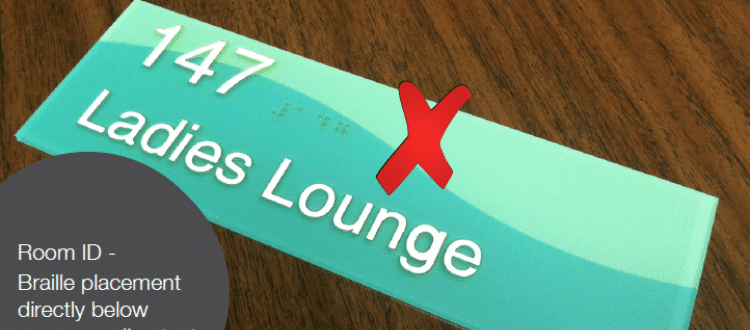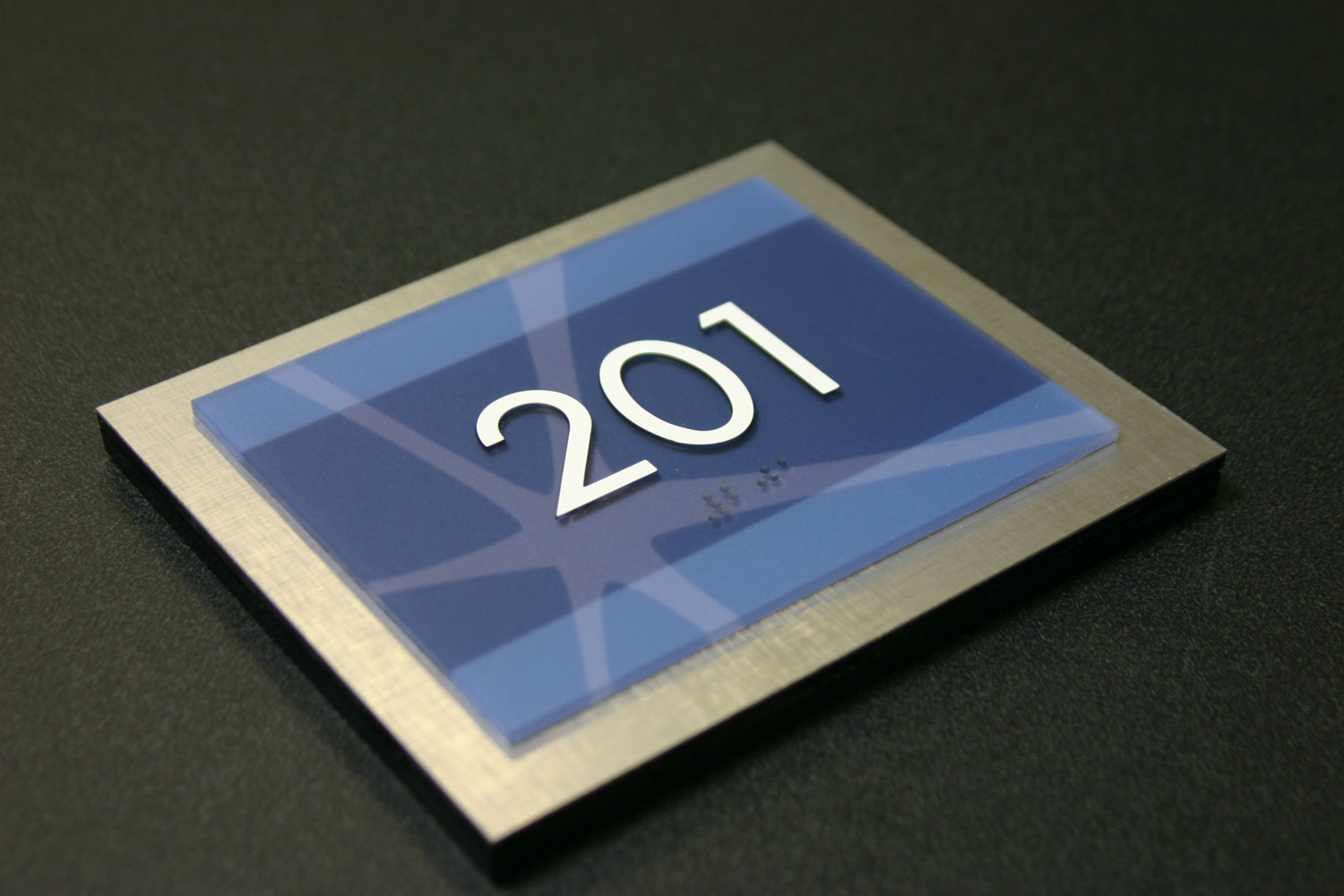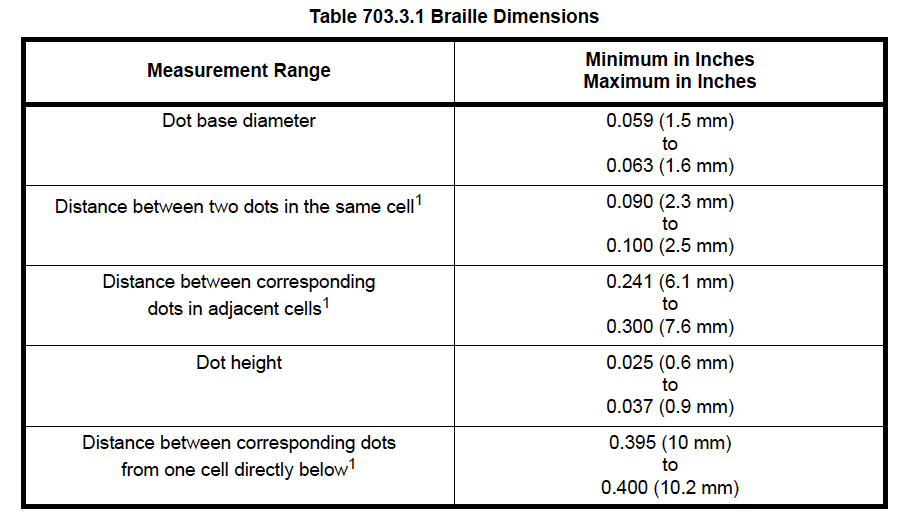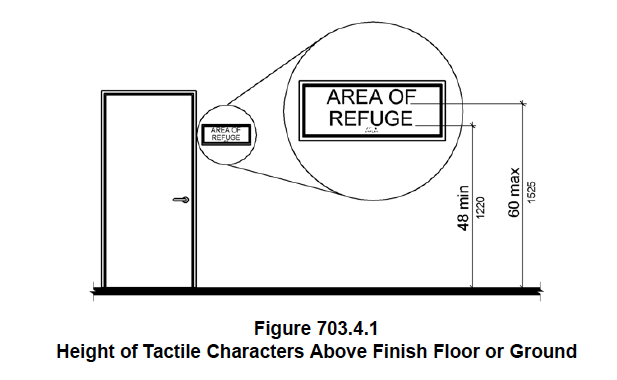5 Reasons Your Signs Are Not ADA Compliant
The Five Essentials of ADA signs
So we start with two questions:
- Have you even had any of your ADA signs rejected because they didn’t meet a local, state or federal ordinance?
- Have you ever been in a building where you noticed ADA signage that left something to be desire? Like maybe some letters or Braille characters were loose or even falling off? Or the letters were too small or too tightly spaced?
Bear your answers to these questions in mind and remember that the requirements for ADA signs are not very complicated and that by paying attention to a few makes all the others easy. The regulations presently in place go back to 2010 and should be required reading for anyone specifying, designing or fabricating ADA signs.
While ADA-compliant signs are produced everyday, most problems with non-compliant signs stem from one of two things: lack of knowledge or ignoring the guidelines while attempting to meet a specific design aesthetic. Under the Americans with Disabilities Act (ADA) of 1990, businesses and governments are required to make accommodations for people who are legally disabled. In fact, most ADA violations generally involve failure to provide access and amenities in public places for persons with disabilities.
ADA Compliance: Violation Penalties
The cost of non-compliance is not trivial: The penalty for the first violation is $75,000 with each additional offense being $150,000. Those can add up to real money pretty quickly, and the building owner will come to you, the sign fabricator, or the architect or designer when a local inspector says your signs are not up to spec.
This puts the obligation on you to make sure your signage meets ADA guidelines, not only because it’s the law, but because you’re creating something that makes a building’s environment more accessible to people with visual disabilities. The entire body of regulations is a few layers deep, but the five most common ADA signage rules are primarily about character spacing and fonts, with the goal of making wayfinding and navigating as easy as possible for visually impaired people. The associated violations touch on the areas most noticed by the signage inspectors who’ll come calling if your work is found wanting.
1. Font: The 4-Letter Word in ADA Signage
We all have about a billion fonts available to us, which is maybe why the word font can seem like a four-letter word in the world of sign design. Still, some sign designers aren’t aware of all the ADA signage rules, that character size is regulated, and that all tactile lettering—characters one can identify by touch–on ADA signs should be sans serif.
The language in the 2010 Standard for Accessible Design is very straightforward:
- 703.2.2 Case. Characters shall be uppercase.
- 703.2.3 Style. Characters shall be sans serif. Characters shall not be italic, oblique, script, highly decorative, or of other unusual forms.
- 703.2.4 Character Proportions. Characters shall be selected from fonts where the width of the uppercase letter “O” is 55 percent minimum and 110 percent maximum of the height of the uppercase letter “I”.
- 703.2.5 Character Height. Character height measured vertically from the baseline of the character shall be 5/8 inch (16 mm) minimum and 2 inches (51 mm) maximum based on the height of the uppercase letter “I”.
Why, you may ask? Try this. Have your sign fabricator create two signs for you with just two or three words on each: one sign in a sans serif font like Helvetica and the other (with different words) in say, Times Roman. Be sure you aren’t told what the words are. Now close your eyes and try to “read” the word with your fingers. Which one was easiest for you to “read” with your fingers?
Of course, not everyone wants to use Helvetica (or Arial) for everything, but these simple fonts work well for ADA signage. Moreover, they meet the expectations of visually impaired people, which is critical for these applications. From an aesthetic point of view, there are many other ways to make ADA signs more decorative using colors, shapes, and different materials. Another option is creating dual message signs, where ADA-required tactile features blend in with a background, and the visual features are above. This can allow you to use lowercase text or serif fonts for the visual message and making your signs custom.
The regs allow for this:
- 703.1 General. Signs shall comply with 703. Where both visual and tactile characters are required, either one sign with both visual and tactile characters, or two separate signs, one with visual, and one with tactile characters, shall be provided.
There are several exemptions in the code that refer to the requirement for Dual Message Signs, and there’s more of that below.
2. KERNING: Why Do Those Letters Look Funny?
Typesetting fans love to adjust kerning—the space between letters—which can make kerning a frustrating part of ADA guidelines. The rules are quite restrictive, specifying a minimum of 1/8” between the two closest points of any tactile characters.
- 703.2.7 Character Spacing. Character spacing shall be measured between the two closest points of adjacent raised characters within a message, excluding word spaces. Where characters have rectangular cross sections, spacing between individual raised characters shall be 1/8 inch (3.2 mm) minimum and 4 times the raised character stroke width maximum. Where characters have other cross sections, spacing between individual raised characters shall be 1/16 inch (1.6 mm) minimum and 4 times the raised character stroke width maximum at the base of the cross sections, and 1/8 inch (3.2 mm) minimum and 4 times the raised character stroke width maximum at the top of the cross sections. Characters shall be separated from raised borders and decorative elements 3/8 inch (9.5 mm) minimum.
This is pretty straightforward. What makes it a bit tricky is that some character pairs are naturally closer together, but that to be ADA compliant those character pairs need to be spaced further apart, making the spacing wider than normal.
So here’s the thing: ADA signs are intended to be effective for the visually impaired, not aesthetically pleasing to typographers. The 1/8” kerning minimum and character size rules (that’s coming next) can cause issues with the size of the sign. The simple solution would be to squeeze everything together to make the word fit on the sign. This, of course, is not compliant and makes tracing the letters with your fingers very difficult. Doubt this? Have your designer make some signs using “normal” visual kerning, and ADA kerning, then close your eyes and try to figure out which words are being used.
The idea here is that tactile characters help people with visual disabilities trace their fingers along the tactile letter and numbers to read the name of the room. Behind this is that the number of people who can read Grade II Braille is low, so wider kerning and sans serif fonts are the practical solution.
Learn More with our Whitepaper: The ADA and Typography – Types and Pictograms
3. CHARACTER SIZE: Too Big or Too Small
Forget point sizes. The size for tactile sign lettering is simple. The minimum height is 5/8” and the maximum is 2”. This rule is often broken when the design doesn’t allow enough room for both compliant Braille and tactile lettering. It also happens a lot with certain frame systems.
- 703.2.5 Character Height. Character height measured vertically from the baseline of the character shall be 5/8 inch (16 mm) minimum and 2 inches (51 mm) maximum based on the height of the uppercase letter “I”.
The exception to this rule is with the Dual Message Sign, one meant to provide the same information for sighted and visually impaired people. In such cases, tactile characters can be as small as 1/2” high. The ruling reads: “Where separate raised and visual characters with the same information are provided, raised character height shall be permitted to be ½ inch (13 mm) minimum.”
Between character size, height and kerning, it’s easy to produce Dual Message signs that are inadvertently out of compliance, so be sure to pay attention to the rules.
4. ADA BRAILLE STANDARDS: Are you sure that’s Compliant?
There are many different ways to manufacture Braille signs and you can make compliant Braille with all the fabrication methods. The 2010 Standard contains specific codes relating to Braille that include structure of the dot, its height above the surface of the substrate, cell spacing and placement. Although language of the guidelines neither includes nor excludes any materials, the description of the shape of the Braille dots is very specific about the shape and size of each Braille dot and cell.
- 703.3.1 Dimensions and Capitalization. Braille dots shall have a domed or rounded shape and shall comply with Table 703.3.1.
In the U.S., signs are required to have Grade II Braille, which incorporates 189 contractions and short form words. The condensed size of the Braille is ideal for the limited space available on most signs.
Title 24 in California uses different spacing for Braille. California Braille, as it’s commonly called, uses Grade II Braille with increased spacing between Braille cells. Title 24 also has different requirements for placement of the Braille. For example, both the 2010 Standard and Title 24 require the Braille to be at least 3/8” directly below the corresponding text. Title 24 sets the maximum distance of 1/2”. Both require the Braille to be directly below the text, so no, you cannot put the Braille to the right of the text. This is done so visually impaired people know where the Braille cells to be, so they don’t have to guess and try to find the cells they need.
The uppercase indicator before Braille is not often required, but since many people are not sure when to use it, it is actually used frequently. The codes states that “The indication of an uppercase letter or letters shall only be used before the first word of sentences, proper nouns and names, individual letters of the alphabet, initials, and acronyms.”
5. MOUNTING HEIGHT: Is That Sign Too Low? Or too High?
The 2010 Standard changed the mounting requirements for ADA signs. There is now a variance of 48″ to 60”. An important thing to note is that the mounting height of the sign is base on the height of the tactile characters above the finished floor. It’s a simple matter for a sign installer to measure the height above the finished floor when placing signs, but you need to make sure they are taking this minor step for every sign they install.
The code spells out most of the mounting scenarios in detail. If you ever have a situation where you’re uncertain the correct location to mount an ADA sign, ask the local building inspector. Unfortunately, as many of you know, different people have different interpretations of the codes, especially when it comes to mounting location.
- 703.4.1 Height Above Finish Floor or Ground. Tactile characters on signs shall be located 48 inches (1220 mm) minimum above the finish floor or ground surface, measured from the baseline of the lowest tactile character and 60 inches (1525 mm) maximum above the finish floor or ground surface, measured from the baseline of the highest tactile character.
EXCEPTION:Tactile characters for elevator car controls shall not be required to comply with 703.4.1. - 703.4.2 Location. Where a tactile sign is provided at a door, the sign shall be located alongside the door at the latch side. Where a tactile sign is provided at double doors with one active leaf, the sign shall be located on the inactive leaf. Where a tactile sign is provided at double doors with two active leafs, the sign shall be located to the right of the right hand door. Where there is no wall space at the latch side of a single door or at the right side of double doors, signs shall be located on the nearest adjacent wall. Signs containing tactile characters shall be located so that a clear floor space of 18 inches (455 mm) minimum by 18 inches (455 mm) minimum, centered on the tactile characters, is provided beyond the arc of any door swing between the closed position and 45 degree open position.
EXCEPTION: Signs with tactile characters shall be permitted on the push side of doors with closers and without hold-open devices.
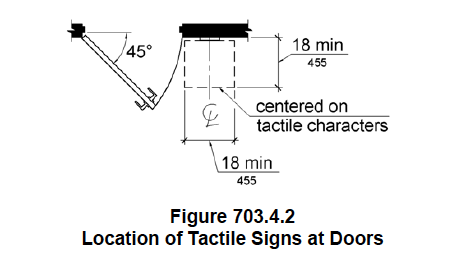
None of this is complicated, but each guideline requires some attention to detail. By knowing the rules you can become an ADA sign expert, share your knowledge with building owners, architects and designers, and become a valued resource. And, you can complete each ADA job knowing it is fully compliant with all regulations.

